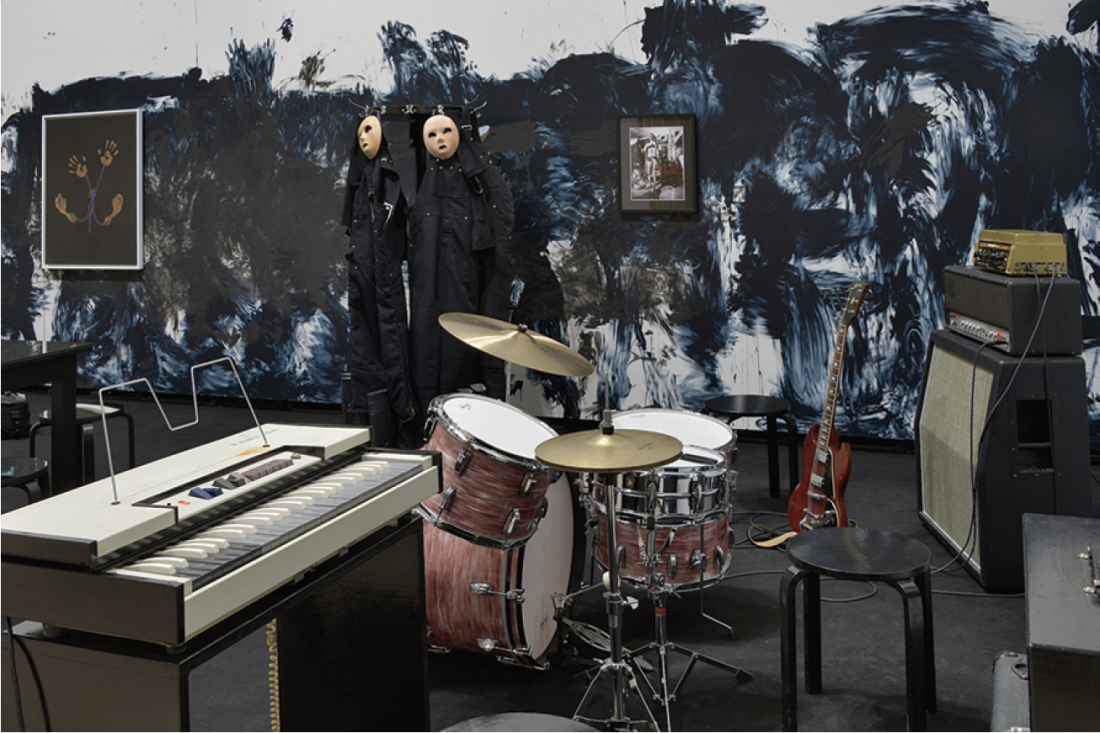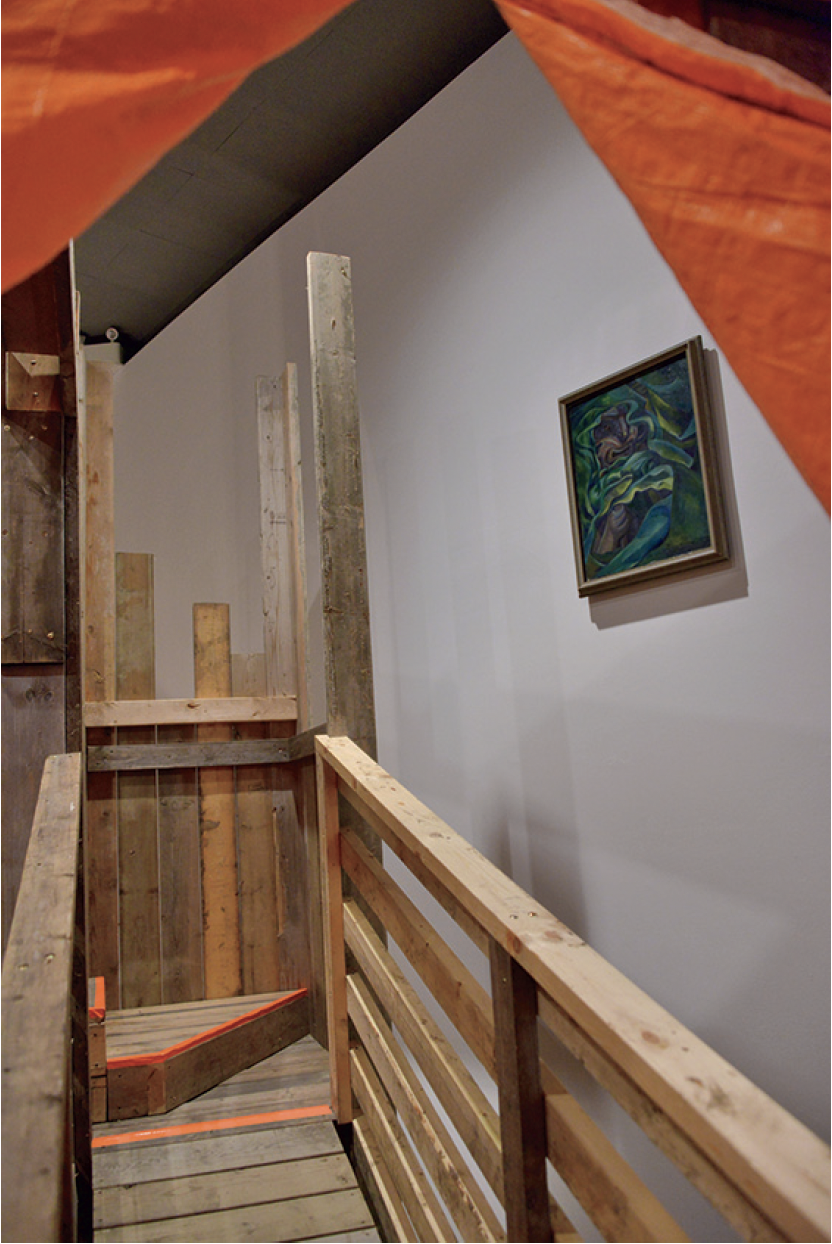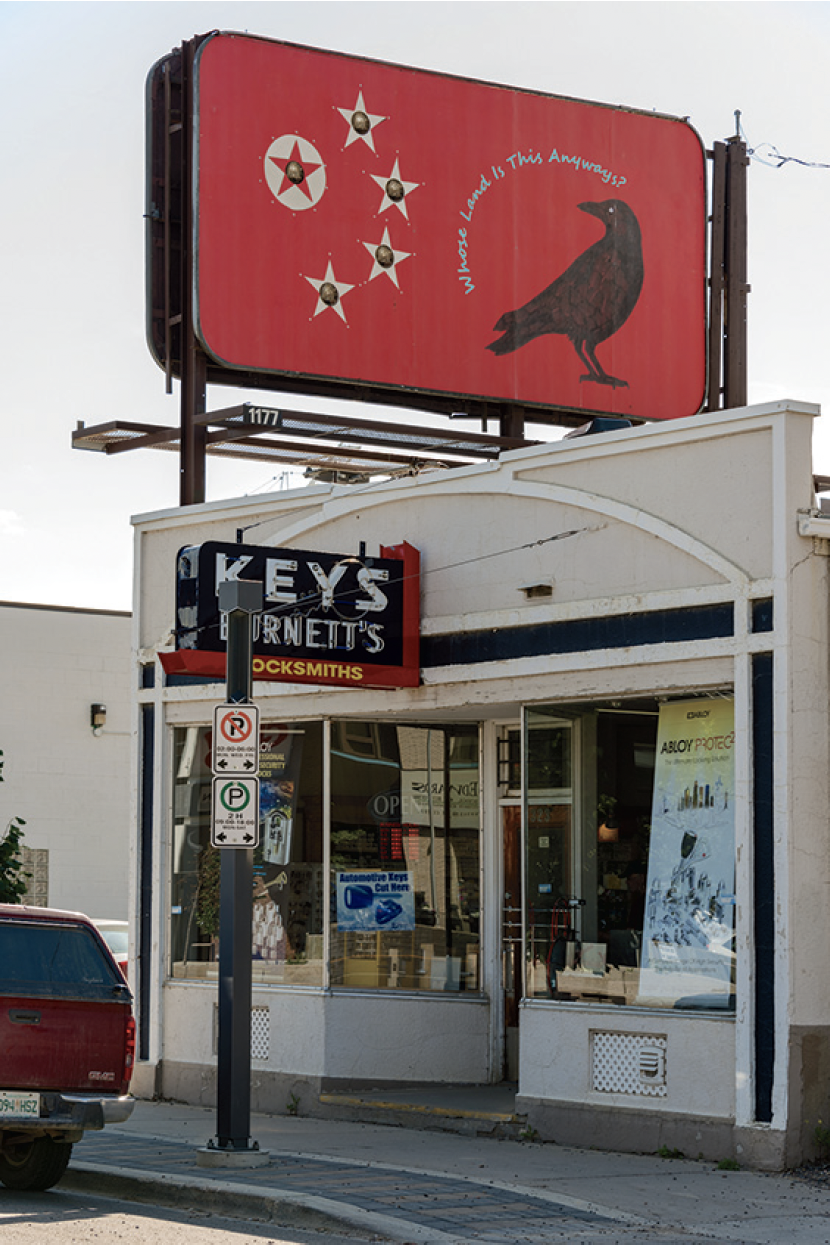“Convoluted Beauty: In the Company of Emily Carr”
Curator Lisa Baldissera mashes art like a DJ to spin new readings around Emily Carr and what she calls her “folk-artist” aura. Walk into “Convoluted Beauty” and wang-out/self-heal on Thomas Zipp’s electric guitar. Climb Nathan and Cedric Bomford’s improvised two-story tower/plein-air studio, or sit back in the Civic Conservatory adjoining the Mendel Art Gallery and soak up Louise Lawler’s Birdcalls, 1972–81. Look up, way up, to spot an exquisite little Carr: Strangled by Growth, 1931, hanging about 20 feet high on the wall. When your neck gets sore, climb the tower Down by the River, 2014, to the second story, past Carr’s notebook and get up close.
Baldisserra recalls seeing the special presentation of Carr’s work at dOCUMENTA (13), 2012, and realizing that she could hold her own with the best—that her parochial art-historical position in the munificent shadow of the Group of Seven needed to be rethought.
This show is very ambitious. It brings together cutting-edge art-historical research, new interpretive schemes and an activist, authorial, even artistic model for curatorial work. Baldissera’s credentials are impressive: she curated over 90 exhibitions at The Art Gallery of Greater Victoria, she’s working on her PhD at Goldsmiths College and her major monograph on Emily Carr will be published by the Art Canada Institute, Massey College in February 2015. She doesn’t shy away from explicit curatorial intervention and she’s not afraid of a little free association.

Thomas Zipp, Figure-Ground Specification in Terms of Structural Information. The Rivalry Between Different Pattern Codings (detail), 2013, mixed-media installation, dimensions variable. Courtesy Galerie Guido W Baudach, Berlin. All Photographs: Troy Mamer.
“Collecting and vocalizing bird words in partially familiar languages can be uplifting, as many poets can confirm.” This unusually prosaic statement from Joanne Bristol’s post-human and very avant-gardist broadsheet, Le Vol Quotidien, 2014, devoted to new interspecies relations (especially with birds), proposes a revalued and very appropriate frame for Carr. It also makes a perfect segue to Louise Lawler’s Birdcalls, 1972–81, her historic, feminist play on art-world patriarchy. Birdcalls, in which Lawler calls out the names of successful male artists in bird-like tweets, may have found its perfect situation in the Civic Conservatory adjacent to the Mendel Art Gallery.
In her final exhibition as the Mendel Art Gallery’s Chief Curator (Baldissera’s resignation came just two years into her tenure), Emily Carr, with her mythic embrace of animals and her maladjusted social skills, becomes a prototype for interspecies coexistence. But that’s the sidebar. “Convoluted Beauty” is a densely layered examination of a time in Carr’s life/work that has always been considered unproductive: her four-year sojourn in England and the period after she was diagnosed with hysteria and interned for 18 months at East Anglia Sanatorium in Suffolk.
Carr’s English “downtime” re-emerges in Baldiserra’s scheme as a pregnant moment that ultimately bears precious fruit. Her contention is that Carr discovered both her artistic and national identities by removing herself from the ridgid and conformist artistic society of turn of the century Victoria, BC, interestingly by falling into wayward internment in the motherland. This revaluation of Carr’s dysfunction (for example, her outsider status, her mental illness and her eccentricities) breathes new life into the scholarship on the artist (and all artists). It also bears a nagging resemblance to Romantic notions of artistic genius, characterized by misunderstanding and social maladaptation.

Cedric and Nathan Bomford, Down by the River (detail), 2014, mixed-media installation, dimensions variable; Emily Carr, Strangled by Growth, 1931, oil on canvas, 64 x 48.6 cm. Collection of the Vancouver Art Gallery, Emily Carr Trust. Courtesy Mendel Art Gallery, Saskatoon.
Karen Tam’s loving, if overly cautious re-presentation of the studio of traditional Chinese painter, Lee Lee-Nam: Flying Cormorant Studio (For Lee Nam), 2014, situates Carr, alongside her expatriate friend, as an outsider. Neither gained acceptance into the colonial society of Victoria’s artists, burdened as it was with chronic Anglophilia. What seems strange is that Carr, during these years of social and professional non-acceptance, must also have pinned her cultural identity to England because it wasn’t long afterwards that she made her own pilgrimage there. Baldiserra reminds us that her parents were British immigrants so it’s no surprise that Carr expected to share their feelings of cultural allegiance. Whether it was the tribulations of the sanatorium or the deeper complex of convulsive resistances that led to her breakdown, her attitude to England crystallized when an orchid in her hospital room suddenly died: “both of us,” she wrote, “were thoroughly un-English.”
The outsider theme runs throughout the exhibition in different variations and with differing political and psychological implications. Mark Wallinger’s Threshold to the Kingdom (first shown in the British pavilion at the Venice Biennale, 2001) is an operatic study of air passengers “shuttling from one position to another” as they walk through the no-man’s-land of customs and the international arrivals gate of London’s City airport—monumentalized with a rendition of Gregorio Allegri’s Miserere and choreographed in slow motion.
Kwakwaka’wakw artist Marianne Nicolson was commissioned to produce a billboard for the exhibition, which functioned as a companion piece to a triptych Carnival/Carnivore, 2014, that she presented in the gallery. The billboard, Whose Land Is This Anyways? addressed Carr’s problematized legacy of cultural appropriation. One of the paintings in the show (Return from Fishing, Guydons, 1912), depicts the sea monster house on Gilford Island which happens to have belonged to Nicolson’s great uncle, Chief Johnny Scow. It’s a “cautionary tale,” she writes in correspondence with the curator. An amalgam of Chinese national flag, logos of Texaco Oil, Chevron and Shell, and references to Canadian Tar Sands, it commemorates the 100-year anniversary of the 1914 McKenna-McBride Royal Commission that actually “[allocated] the smallest of reserves possible while opening up the majority of BC Lands for development.”

Marianne Nicolson, Whose Land Is This Anyways? (installed in downtown Saskatoon), 2014, billboard, 304.8 x 609.6 cm. Courtesy Mendel Art Gallery, Saskatoon.
The post-performance installation by Thomas Zipp, Figure-Ground Specification in Terms of Structural Information. The Rivalry between Different Pattern Codings, 2013, had an even more aggressive presence in the gallery than the two-storey Bomford structure (Down by the River, 2014). Understanding hysteria as a “quasi-artistic” phenomenon and the artist as a self-healer or therapist, Zipp reproduced a psychiatric clinic for the Venice Biennale 2013. Here he used music for its mind-altering and therapeutic effects. Figure-Ground Specification… is a kind of nightclub, replete with tables, chairs, drum kit, guitars, keyboards and a vintage echo-machine used to produce psychedelic music. A performance with Zipp on the keyboards inaugurated the exhibition and the public was invited to play the instruments during afternoon opening hours. Zipp’s conflation of hysteria and mental illness with artistic impulse fits the curatorial premise perfectly and reinforces the notion that maladaptation may be a problem of social, cultural or political structure rather than an individual dysfunction.
One of the most haunting entries in the exhibition is a group of 20 reproductions of paintings produced between 1940–43 by the German Jewish artist Charlotte Salomon from the series “Life? Or Theatre? A Play with Music.” It was produced in the south of France during her exile from Nazi Germany when she was in her mid 20s. She was ultimately deported and gassed at Auschwitz, with her unborn child. The complete series comprises 769 gouache paintings that tell her life story using only the three primary colours and white—expressionist figures, swirling, fantastic spaces, and lots of painted text. The epic series was conceived as a Gesamtkunstwerk. Many panels were designed with translucent overlays and the work was to be set to music. Although her biography is tragically intertwined with the Jewish Holocaust, it is really the tragedies in her personal life that prompted the paintings and her inclusion in this exhibition.
Salomon started the series after learning the history of the many suicides of women in her family. She stated that she was motivated by “the question: whether to take her own life or undertake something wildly unusual.” This sounds like classic sublimation. Although Thomas Zipp’s notion that mental illness has an artistic dimension is not the same as the creative re-channelling of drives proposed by psychoanalysis, they are certainly close cousins.
“Convoluted Beauty” is a brilliant thesis and works well to expand the purview of the mythic artist’s creative life, situate her work on the international stage and refresh her relevance. Strong new works were created for the exhibition. However, in the gallery Emily Carr doesn’t shine as brightly as she might, simply because there are so many other strong (and at first, seemingly disparate) artists to contend with. Walking through the exhibition, it took some dedication to stay focused on the symbiotic relationships. Nevertheless, the investment and discipline demanded by Baldissera more than paid off. Without a doubt, the show is an original and rigorous contribution to art historical scholarship and I thank the Mendel for doing its job and putting research first. ❚
“Convoluted Beauty: In the Company of Emily Carr” was exhibited at Mendel Art Gallery, Saskatoon, from June 27 to September 14, 2014.
Marcus Miller is the Director of the Gordon Snelgrove Gallery at the University of Saskatchewan. He is a curator, teacher and critic.

